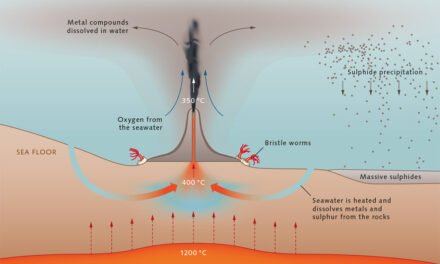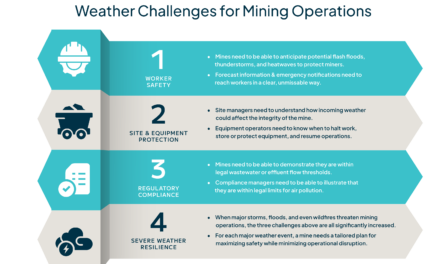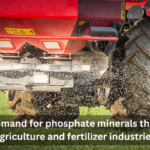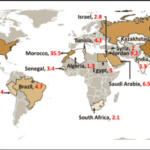Mining carbonate minerals such as limestone, dolomite, and calcite can have significant environmental impacts. These concerns arise primarily due to the large scale of extraction and the nature of the processes involved. Some of the key environmental concerns associated with mining carbonate minerals and their mitigation strategies include:
1. Air Pollution from Dust and Emissions
Concerns:
- Dust Generation: Mining and crushing carbonate ores release fine particulate matter (PM), which can lead to air pollution. Dust from blasting, drilling, and transportation of mined materials can cause health problems for nearby communities and workers, as well as impact surrounding ecosystems.
- Carbon Emissions: The calcination process (heating limestone to produce lime) releases significant amounts of carbon dioxide (CO₂), a major greenhouse gas that contributes to climate change.
Mitigation Measures:
- Dust Control: Implementing water spraying systems, dust suppressants, and enclosed conveyors during transport can significantly reduce airborne dust.
- Dust Collection Systems: Using baghouse filters and cyclone separators in processing plants to capture dust.
- Carbon Capture: Using carbon capture and storage (CCS) technologies in lime production plants to capture and store CO₂ emissions rather than releasing them into the atmosphere.
2. Water Pollution and Acid Mine Drainage
Concerns:
- Acid Mine Drainage (AMD): While carbonate minerals are not as acidic as sulfide minerals, acid mine drainage can still occur if the mining process interacts with acidic solutions or if the minerals undergo chemical reactions that lead to the formation of acidic compounds.
- Leachate Contamination: If acid leaching or other chemical processes are used, there can be a risk of releasing toxic chemicals (such as sulfuric acid or heavy metals) into nearby water sources, leading to contamination of surface and groundwater.
Mitigation Measures:
- Water Management Systems: Installing runoff collection ponds, water treatment plants, and settling ponds to prevent contaminated water from reaching local water bodies.
- Neutralization of Acidic Waters: Using alkaline substances (such as lime or sodium hydroxide) to neutralize acidic waters and prevent them from harming aquatic ecosystems.
- Recycling Water: Implementing water recycling systems in the processing plant to minimize water consumption and reduce the risk of contamination.
3. Habitat Destruction and Biodiversity Loss
Concerns:
- Deforestation: Large-scale mining operations often require clearing of forested areas, leading to the loss of biodiversity, disruption of ecosystems, and habitat destruction for wildlife.
- Soil Erosion: The removal of vegetation and soil during mining can increase soil erosion, particularly in mountainous or hilly regions. Erosion can lead to sedimentation in nearby water bodies, negatively affecting water quality and aquatic life.
Mitigation Measures:
- Sustainable Land Use Planning: Careful site selection to avoid ecologically sensitive areas, and minimizing the footprint of the mine to reduce habitat destruction.
- Reclamation and Reforestation: After mining operations have ended, implement land reclamation practices, including planting native vegetation and reforesting mined areas to restore biodiversity and prevent soil erosion.
- Erosion Control: Installing silt fences, retention ponds, and vegetative cover to control erosion and prevent sedimentation in water bodies.
4. Waste Generation and Tailings Management
Concerns:
- Waste Rock and Tailings: Mining operations produce significant amounts of waste rock and tailings, which may contain contaminants that can leach into the environment. These wastes may remain toxic for long periods and can impact the surrounding land and water.
- Landfill Use: Improper disposal of waste can lead to pollution and take up large amounts of land, further contributing to environmental degradation.
Mitigation Measures:
- Recycling and Reusing Waste: Efforts to reuse waste materials (such as using waste rock for construction or as aggregate) can reduce the need for disposal.
- Tailings Storage Facilities: Properly engineered tailings dams or dry stacking techniques to safely contain and store tailings. Regular monitoring and maintenance of these facilities are crucial to prevent breaches or leaks.
- Mining Waste Treatment: Treating waste before disposal to neutralize harmful chemicals or mitigate leaching.
5. Energy Consumption
Concerns:
- High Energy Use: Mining and processing of carbonate minerals, especially during calcination, can be energy-intensive, leading to significant energy consumption. This contributes to greenhouse gas emissions and resource depletion.
Mitigation Measures:
- Energy Efficiency: Implementing energy-efficient technologies in mining and processing operations, such as using electric-powered equipment or efficient rotary kilns in lime production, can help reduce energy consumption.
- Renewable Energy: Transitioning to renewable energy sources (e.g., solar, wind, or biomass) to power mining operations reduces reliance on fossil fuels and decreases environmental impact.
- Cogeneration: Using waste heat recovery systems to harness energy produced in the process for other operational needs, reducing overall energy requirements.
6. Noise Pollution
Concerns:
- Blasting and Equipment Noise: Mining operations, particularly those involving large-scale drilling and blasting, can generate significant noise. This can disturb wildlife, local communities, and workers, potentially causing health issues such as hearing loss, stress, or interference with animal communication and migration patterns.
Mitigation Measures:
- Noise Barriers: Constructing noise barriers around mining operations or around sensitive areas like communities and wildlife habitats to minimize sound propagation.
- Blasting Controls: Implementing controlled blasting techniques that reduce the intensity and frequency of noise during operations.
- Equipment Noise Reduction: Using low-noise mining equipment and ensuring that machinery is well-maintained to reduce noise emissions.
7. Human Health and Safety Concerns
Concerns:
- Worker Exposure: Mining operations pose health risks to workers due to the potential exposure to harmful dust, noise, and chemicals used in leaching processes.
- Community Health: Communities near mining operations may experience health issues due to dust inhalation, water contamination, or the release of gases like CO₂.
Mitigation Measures:
- Health and Safety Regulations: Implementing strict workplace safety standards, including personal protective equipment (PPE), air filtration systems, and regular health monitoring of workers.
- Community Engagement: Engaging with local communities to inform them about mining operations and the steps taken to minimize environmental risks. Providing clean water and medical services to affected communities.
Conclusion
The environmental concerns associated with mining carbonate minerals such as limestone, dolomite, and calcite are varied and include air and water pollution, habitat destruction, waste generation, energy consumption, and noise. However, these challenges can be effectively mitigated through best practices, including dust control, water treatment systems, land reclamation, energy efficiency, and proper waste management.
By adopting sustainable mining practices, implementing green technologies, and maintaining strong environmental monitoring, the environmental footprint of carbonate mineral extraction can be reduced, ensuring that mining operations are more eco-friendly and that local communities and ecosystems are protected.














